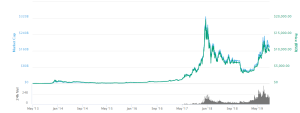The Genesis of Bitcoin Gold: Addressing Centralization Concerns
Rediscover the true spirit of Bitcoin with Bitcoin Gold (BTG)! Mine BTG easily, even with standard hardware. Join the decentralized revolution and reclaim your crypto power. Learn more now!
Bitcoin Gold (BTG) emerged as a fork of the original Bitcoin blockchain in 2017․ Its primary aim was to address concerns about Bitcoin’s increasing centralization and the growing difficulty of mining for individual users․ This decentralization effort involved a significant technological shift, altering the mining algorithm to make it more accessible to individuals with standard computer hardware․ The project aimed to return Bitcoin to its original ethos of decentralized, egalitarian mining․ This, however, presented its own unique set of challenges and opportunities․
The rise of specialized mining hardware, known as ASICs (Application-Specific Integrated Circuits), had created a significant barrier to entry for individual Bitcoin miners․ Large mining pools, possessing vast resources of ASICs, dominated the Bitcoin network, leading to concerns about centralization and the potential for manipulation․ Bitcoin Gold sought to counter this trend by implementing a new mining algorithm, Equihash․ This algorithm was designed to be more resistant to ASIC mining, making it more feasible for individuals to participate in the mining process using readily available graphics processing units (GPUs)․
The transition to Equihash was a pivotal moment in Bitcoin Gold’s history․ It marked a clear departure from the original Bitcoin protocol, aiming for a more distributed and inclusive mining landscape․ The developers behind Bitcoin Gold argued that this change was essential to preserve the spirit of decentralization that was fundamental to Bitcoin’s initial vision․ However, this change also introduced its own complexities and unforeseen consequences․
The Equihash Algorithm and its Implications
Equihash’s resistance to ASICs was a double-edged sword․ While it successfully broadened participation in mining, it also introduced its own set of challenges․ The algorithm proved to be more computationally intensive than SHA-256, Bitcoin’s original algorithm, leading to higher energy consumption per unit of mining power․ Furthermore, the development of ASICs specifically designed for Equihash eventually emerged, albeit slower than for SHA-256, partially undermining the initial goal of preventing large-scale mining centralization․
This evolution highlights the dynamic nature of the cryptocurrency landscape․ What might seem like a definitive solution at one point can be circumvented with technological innovation․ The ongoing arms race between algorithm developers and ASIC manufacturers is a constant factor affecting the balance of power in cryptocurrency networks․
Bitcoin Gold’s Technological Features and Innovations
Beyond the switch to Equihash, Bitcoin Gold incorporated several other features aimed at improving the functionality and usability of the network․ These included enhancements to transaction speed and scalability, as well as efforts to improve the overall security of the blockchain․ However, the impact of these enhancements has been a subject of ongoing discussion and analysis within the cryptocurrency community․
Some argued that these additions were necessary to address limitations inherent in the original Bitcoin protocol․ Others contended that they added complexity without providing significant improvements․ The long-term effectiveness of these innovations remains to be fully evaluated, as the cryptocurrency market is constantly evolving․
Scalability and Transaction Speed Improvements
One of the key challenges facing Bitcoin and other cryptocurrencies is scalability – the ability to handle a growing number of transactions without compromising speed or efficiency․ Bitcoin Gold attempted to address this issue through various technological enhancements․ These efforts, however, have had mixed results, and the network’s scalability remains a subject of ongoing debate among developers and experts․
The development of faster and more efficient transaction processing methods is crucial for the widespread adoption of cryptocurrencies․ The success or failure of Bitcoin Gold’s scalability improvements will be a key factor in determining its long-term viability and relevance in the competitive cryptocurrency market․
The Market Performance and Future of Bitcoin Gold
Since its inception, Bitcoin Gold has experienced significant volatility in its market price, reflecting the overall instability of the cryptocurrency market․ Its value has fluctuated dramatically, influenced by factors such as market sentiment, technological developments, and regulatory changes․ While it initially attracted significant attention, its market capitalization has remained relatively modest compared to other major cryptocurrencies․
The future of Bitcoin Gold is uncertain, and its success will depend on several factors․ These include its ability to attract and retain users, its capacity to adapt to evolving technological advancements, and the overall trajectory of the cryptocurrency market․ The project faces stiff competition from other cryptocurrencies, many of which offer superior functionality or market appeal․
Challenges and Opportunities for Bitcoin Gold
Bitcoin Gold faces several significant challenges․ Maintaining its network security against potential attacks is crucial․ Furthermore, attracting and retaining developers is essential for ongoing innovation and improvement․ Competition from other cryptocurrencies, some of which possess larger market capitalization and stronger community support, presents a substantial obstacle․
However, opportunities also exist․ Bitcoin Gold could potentially benefit from increased adoption of cryptocurrencies in general․ Technological advancements and improvements could enhance its functionality and appeal․ Strategic partnerships and collaborations could also contribute to its growth and development․
Comparing Bitcoin Gold to Other Cryptocurrencies
Bitcoin Gold occupies a unique niche within the cryptocurrency landscape․ While it shares some similarities with Bitcoin, its distinct technological features and goals differentiate it from its predecessor and other prominent cryptocurrencies․ Understanding these differences is crucial for investors and users alike․
- Mining Algorithm: Bitcoin Gold utilizes Equihash, unlike Bitcoin’s SHA-256, aiming for more decentralized mining․
- Market Capitalization: Bitcoin Gold generally has a significantly lower market cap than Bitcoin, indicating a smaller overall market presence․
- Community Size: The community surrounding Bitcoin Gold is smaller than that of Bitcoin, potentially impacting development and adoption․
- Transaction Fees: Transaction fees on Bitcoin Gold may vary compared to Bitcoin, influenced by network congestion and demand․
A comparison with other cryptocurrencies such as Litecoin, Ethereum, and Monero reveals further nuances․ Each cryptocurrency has its own set of strengths and weaknesses, making it important to consider individual needs and priorities when selecting a cryptocurrency for investment or use․
Understanding the Risks and Rewards of Investing in Bitcoin Gold
Investing in Bitcoin Gold, like any cryptocurrency, involves significant risks․ The cryptocurrency market is notoriously volatile, and the value of Bitcoin Gold can fluctuate dramatically in short periods․ Regulatory uncertainty further adds to the risk profile․ It’s crucial to conduct thorough research and understand these risks before investing any funds․
However, potential rewards also exist․ If Bitcoin Gold achieves widespread adoption or experiences significant technological advancements, its value could potentially increase substantially․ Like any investment, however, it’s crucial to approach it with caution and a long-term perspective, considering the volatility inherent in the cryptocurrency market․
- Market Volatility: The cryptocurrency market is highly susceptible to rapid price swings․
- Regulatory Uncertainty: Government regulations regarding cryptocurrencies can significantly impact their value․
- Technological Risks: Security vulnerabilities or technological limitations could negatively affect the cryptocurrency․
- Competition: The cryptocurrency market is highly competitive, with many projects vying for market share․
Careful consideration of these risks and rewards, along with a diversified investment strategy, is essential for mitigating potential losses and maximizing potential gains․ It’s also crucial to only invest what you can afford to lose․






